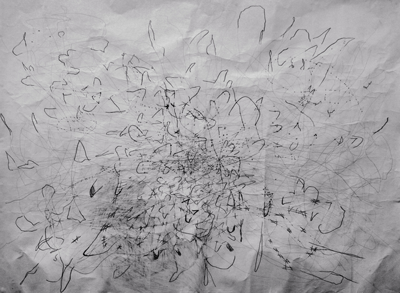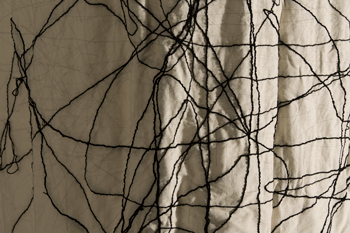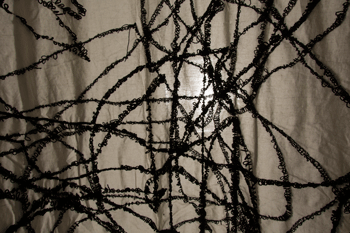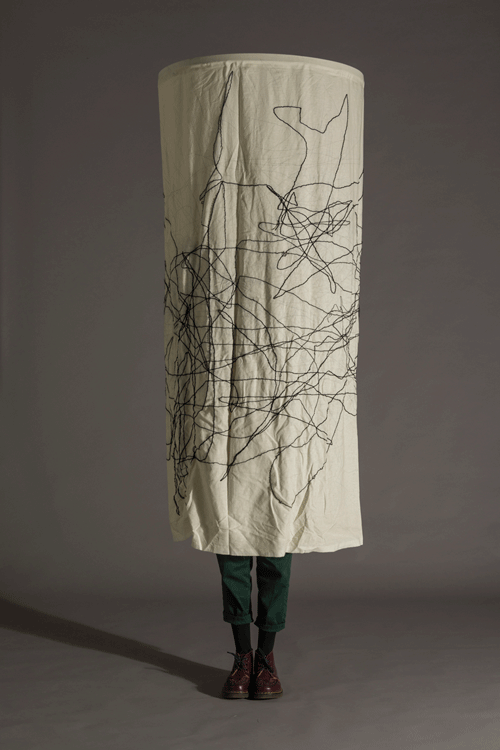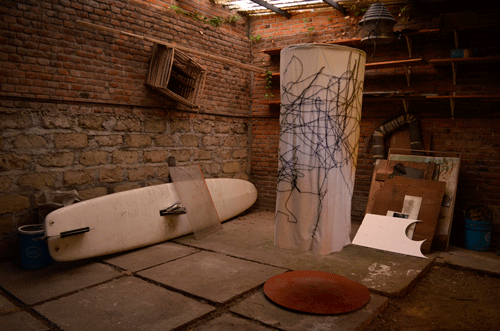entrelazar,
entrelAZAR, entre el azar
|
Proyecto que consistió en un principio de dibujo a lápiz,
realizando una investigación formal sobre los límites en el
espacio, lo limítrofe.
El proyecto entrelazar, entrelAZAR, entre el azar, es
parte de una investigación formal sobre los límites en el
espacio, lo limítrofe. El proyecto fue realizado en dos fases,
la primera consistió en dibujo a lápiz, tomando en cuenta la
línea y el punto como unidad mínima, se
"tiraron" líneas al azar que recorrieron todo el papel. La
línea fue pensada como elemento de unión y también de
división, y el punto como el lugar desde donde se origina la
intersección entre estas; quería producir conexiones. El
dibujo como líneas y puntos, generadores de micro y macro
espacios.
La segunda fase del proyecto fue llevar la cartografía,
resultado del "ejercicio" anterior, a lo tridimensional. El
objetivo fue construir un espacio personal e individual, una
guarida cálida o templo que se pudiera visitar (entrar y
salir), para lo cual propuse un contenedor de un sólo cuerpo,
una “casa o lugar propio” con forma cilíndrica. Se intervino
el contenedor cilíndrico con el mismo material con el
que está compuesta la tela, el hilo. Entrelacé los hilos y
bordé líneas al azar. Tomando en consideración las cualidades
del bordado, decidí que el lado exterior fuera el punto raso y
el lado interior, aquel donde el bordado aparecía con más
textura: es más visceral y entrañable, aquí hacía referencia a
lo íntimo y lo privado.
Punto, línea y plano. Hilo, tela y contenedor.
El punto es a la línea como la línea es al plano. El hilo es a la tela como la tela es al contenedor.
El contenedor fue construido con tela, con el objetivo de
relacionarlo con la casa: la tela como material que protege y
que forma parte de nuestra cotidianeidad, está presente en los
hogares, en todos los espacios de la casa como las cortinas,
los manteles, las toallas, las sábanas, los tapetes, en los
muebles, los sillones, los cojines y en el cuerpo pues
vestimos con telas. El cilindro como contenedor de un cuerpo y
la tela como membrana: el umbral entre el interior y el
exterior (el límite). Esta reflexión me llevo a construir un
espacio íntimo y privado dentro de un espacio público (cuando
la pieza se activa o se expone y tiene interacción con un
cuerpo) a partir de un elemento frágil: la tela. Ésta al estar
suspendida, se convierte en un objeto escultórico, pero sin
ser sólida, intentaba retratar lo vulnerable del espacio
intimo. |
The project consisted of an initial pencil drawing, conducting a formal investigation into the boundaries in space, the liminal.
The project entrelazar, entrelAZAR, entre el azar, is part of a formal investigation into the boundaries in space, the liminal. The project was carried out in two phases. The first phase consisted of pencil drawing, taking into account the line and the dot as the minimal unit. Random lines were "thrown" across the entire paper. The line was conceived as both a connecting and dividing element, while the dot represented the point of origin for the intersection between them; I wanted to create connections. The drawing involved lines and dots, generating micro and macro spaces.
The second phase of the project involved translating the cartography, resulting from the previous "exercise," into three-dimensional form. The objective was to construct a personal and individual space, a warm retreat or temple that could be visited (entered and exited). For this purpose, I proposed a single-bodied container, a cylindrical "house or personal place." The cylindrical container was intervened with the same material as the fabric, the thread. I intertwined the threads and embroidered random lines. Considering the qualities of embroidery, I decided that the outer side would feature a plain stitch, while the inner side, where the embroidery appeared with more texture, would be more visceral and intimate. Here, I made reference to the intimate and the private.
Point, line, and plane. Thread, fabric, and container.
The point is to the line as the line is to the plane. The thread is to the fabric as the fabric is to the container.
The container was constructed with fabric, with the aim of relating it to the concept of a house: fabric as a material that protects and is part of our everyday life, present in homes, in various spaces such as curtains, tablecloths, towels, sheets, rugs, furniture, sofas, cushions, and clothing. The cylinder as a container for a body and the fabric as a membrane: the threshold between the interior and the exterior (the boundary). This reflection led me to create an intimate and private space within a public space (when the piece is activated or exhibited and interacts with a body) using a fragile element: fabric. When suspended, it becomes a sculptural object, but without being solid, attempting to portray the vulnerability of intimate space. |
| Cartografía del
micro-espacio, 2014. Dibujo (grafito sobre papel Bond), 70x94 cm. |
Micro-space Cartography, 2014. Drawing (graphite on Bond paper), 27.5x37 inches. |
| entrelazar, entrelAZAR,
entre el azar, 2014. Escultura textil (tela con bordado a mano), 154cm de altura x 64cm de diámetro. |
entrelazar, entrelAZAR,
entre el azar, 2014. Textile sculpture (hand-embroidered fabric), 60.62 inches in height x 25.19 inches in diameter. |
